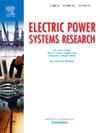Realization of rational models for tower-footing grounding systems
IF 4.2
3区 工程技术
Q2 ENGINEERING, ELECTRICAL & ELECTRONIC
引用次数: 0
Abstract
A tower footing grounding system plays an essential role in lightning-related overvoltages. For time-domain analysis, using an Electromagnetic Transient (EMT) program, one typically has to resort to a rational approximation of the harmonic impedance or a frequency-dependent network equivalent (FDNE) for the grounding system. Although one may obtain a rational approximation in several ways, a discussion of the impact of the topology considered for the rational approximation and the effect of the effective length in this realization has not been presented in the literature. Thus, this work focused on these two aspects. First, a comparison of either approach regarding a minimum-order representation. Second, comparing the two possible topologies of the rational approximation order and its relationship with the effective length. The results indicate that an accurate FDNE is slightly more robust if the effective length is respected.
塔基接地系统合理模型的实现
塔底接地系统在雷击过电压中起着至关重要的作用。对于时域分析,使用电磁瞬变(EMT)程序,通常必须采用谐波阻抗的合理近似或接地系统的频率相关网络等效(FDNE)。虽然人们可以通过几种方式获得有理逼近,但在文献中尚未提出关于为有理逼近所考虑的拓扑的影响以及在这种实现中有效长度的影响的讨论。因此,本工作主要围绕这两个方面展开。首先,关于最小阶表示的两种方法的比较。其次,比较了两种可能拓扑的有理逼近阶数及其与有效长度的关系。结果表明,如果考虑有效长度,精确的FDNE的鲁棒性略强。
本文章由计算机程序翻译,如有差异,请以英文原文为准。
求助全文
约1分钟内获得全文
求助全文
来源期刊

Electric Power Systems Research
工程技术-工程:电子与电气
CiteScore
7.50
自引率
17.90%
发文量
963
审稿时长
3.8 months
期刊介绍:
Electric Power Systems Research is an international medium for the publication of original papers concerned with the generation, transmission, distribution and utilization of electrical energy. The journal aims at presenting important results of work in this field, whether in the form of applied research, development of new procedures or components, orginal application of existing knowledge or new designapproaches. The scope of Electric Power Systems Research is broad, encompassing all aspects of electric power systems. The following list of topics is not intended to be exhaustive, but rather to indicate topics that fall within the journal purview.
• Generation techniques ranging from advances in conventional electromechanical methods, through nuclear power generation, to renewable energy generation.
• Transmission, spanning the broad area from UHV (ac and dc) to network operation and protection, line routing and design.
• Substation work: equipment design, protection and control systems.
• Distribution techniques, equipment development, and smart grids.
• The utilization area from energy efficiency to distributed load levelling techniques.
• Systems studies including control techniques, planning, optimization methods, stability, security assessment and insulation coordination.
 求助内容:
求助内容: 应助结果提醒方式:
应助结果提醒方式:


